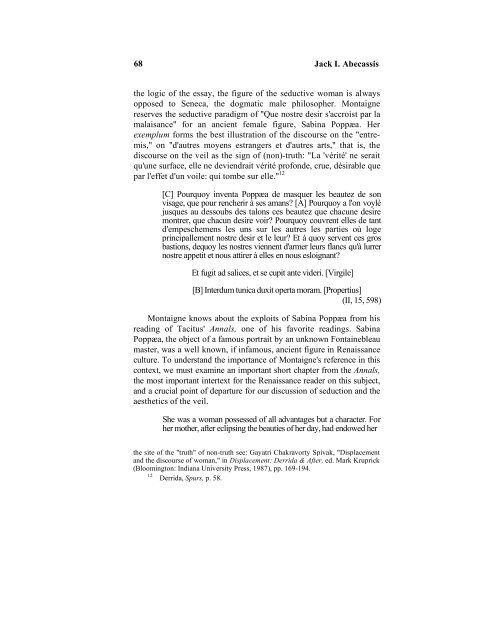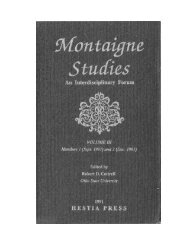Free PDF Download - Montaigne Studies - University of Chicago
Free PDF Download - Montaigne Studies - University of Chicago
Free PDF Download - Montaigne Studies - University of Chicago
You also want an ePaper? Increase the reach of your titles
YUMPU automatically turns print PDFs into web optimized ePapers that Google loves.
68 Jack I. Abecassis<br />
the logic <strong>of</strong> the essay, the figure <strong>of</strong> the seductive woman is always<br />
opposed to Seneca, the dogmatic male philosopher. <strong>Montaigne</strong><br />
reserves the seductive paradigm <strong>of</strong> "Que nostre desir s'accroist par la<br />
malaisance" for an ancient female figure, Sabina Poppæa. Her<br />
exemplum forms the best illustration <strong>of</strong> the discourse on the "entremis,"<br />
on "d'autres moyens estrangers et d'autres arts," that is, the<br />
discourse on the veil as the sign <strong>of</strong> (non)-truth: "La 'vérité' ne serait<br />
qu'une surface, elle ne deviendrait vérité pr<strong>of</strong>onde, crue, désirable que<br />
par l'effet d'un voile: qui tombe sur elle." 12<br />
[C] Pourquoy inventa Poppæa de masquer les beautez de son<br />
visage, que pour rencherir à ses amans? [A] Pourquoy a l'on voylé<br />
jusques au dessoubs des talons ces beautez que chacune desire<br />
montrer, que chacun desire voir? Pourquoy couvrent elles de tant<br />
d'empeschemens les uns sur les autres les parties où loge<br />
principallement nostre desir et le leur? Et à quoy servent ces gros<br />
bastions, dequoy les nostres viennent d'armer leurs flancs qu'à lurrer<br />
nostre appetit et nous attirer à elles en nous esloignant?<br />
Et fugit ad salices, et se cupit ante videri. [Virgile]<br />
[B] Interdum tunica duxit operta moram. [Propertius]<br />
(II, 15, 598)<br />
<strong>Montaigne</strong> knows about the exploits <strong>of</strong> Sabina Poppæa from his<br />
reading <strong>of</strong> Tacitus' Annals, one <strong>of</strong> his favorite readings. Sabina<br />
Poppæa, the object <strong>of</strong> a famous portrait by an unknown Fontainebleau<br />
master, was a well known, if infamous, ancient figure in Renaissance<br />
culture. To understand the importance <strong>of</strong> <strong>Montaigne</strong>'s reference in this<br />
context, we must examine an important short chapter from the Annals,<br />
the most important intertext for the Renaissance reader on this subject,<br />
and a crucial point <strong>of</strong> departure for our discussion <strong>of</strong> seduction and the<br />
aesthetics <strong>of</strong> the veil.<br />
She was a woman possessed <strong>of</strong> all advantages but a character. For<br />
her mother, after eclipsing the beauties <strong>of</strong> her day, had endowed her<br />
the site <strong>of</strong> the "truth" <strong>of</strong> non-truth see: Gayatri Chakravorty Spivak, "Displacement<br />
and the discourse <strong>of</strong> woman," in Displacement: Derrida & After, ed. Mark Kruprick<br />
(Bloomington: Indiana <strong>University</strong> Press, 1987), pp. 169-194.<br />
12 Derrida, Spurs, p. 58.




